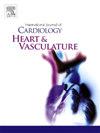经皮冠状动脉介入治疗后的高危患者接受常规压力测试和后续冠状动脉造影术与标准护理的比较:随机对照试验的最新荟萃分析
IF 2.5
Q2 CARDIAC & CARDIOVASCULAR SYSTEMS
引用次数: 0
摘要
本文章由计算机程序翻译,如有差异,请以英文原文为准。

Routine stress testing with subsequent coronary angiography versus standard of care in high-risk patients after percutaneous coronary intervention: An updated meta-analysis of randomized controlled trials
Routine functional stress testing with subsequent coronary angiography is undertaking to detect early restenosis and guide revascularization in high-risk patients after percutaneous coronary intervention (PCI). However, the safety and efficacy of routine functional stress testing over standard care is still debatable. This meta-analysis compares routine functional stress testing vs. standard care in high-risk patients after PCI. We systematically searched PubMed, Embase, and Cochrane Central databases to identify randomized controlled trials (RCTs) that compared functional stress testing versus standard of care after PCI in high-risk patients from inception to January 2025. We calculated the risk ratios (RRs) with 95 % confidence intervals (CIs) using the random-effects model for clinical outcomes. Four RCTs with 6,290 patients, of whom 3,206 (51 %) underwent routine functional stress testing were included in our analyses. The incidence of target lesion revascularization (TLR) was higher in routine functional stress testing (RR: 1.49; 95 % CI: 1.02–2.18; p = 0.038) compared with standard care. However, no statistically significant difference was observed for individual outcomes of all-cause mortality (RR: 0.89; 95 % CI: 0.48–1.18; p = 0.198), myocardial infarction (MI) (RR: 0.62; 95 % CI: 0.31–1.24; p = 0.174), and hospitalization for any cause (RR: 1.22; 95 % CI: 0.24–6.10; p = 0.809). The risk of MACE did not significantly differ between the groups (RR: 1.11; 95 % CI: 0.82–1.51; p = 0.480). Routine functional stress testing after PCI in high-risk patients was associated with increased incidence of target lesion revascularization, without reducing the risk of major adverse cardiovascular events.
求助全文
通过发布文献求助,成功后即可免费获取论文全文。
去求助
来源期刊

IJC Heart and Vasculature
Medicine-Cardiology and Cardiovascular Medicine
CiteScore
4.90
自引率
10.30%
发文量
216
审稿时长
56 days
期刊介绍:
IJC Heart & Vasculature is an online-only, open-access journal dedicated to publishing original articles and reviews (also Editorials and Letters to the Editor) which report on structural and functional cardiovascular pathology, with an emphasis on imaging and disease pathophysiology. Articles must be authentic, educational, clinically relevant, and original in their content and scientific approach. IJC Heart & Vasculature requires the highest standards of scientific integrity in order to promote reliable, reproducible and verifiable research findings. All authors are advised to consult the Principles of Ethical Publishing in the International Journal of Cardiology before submitting a manuscript. Submission of a manuscript to this journal gives the publisher the right to publish that paper if it is accepted. Manuscripts may be edited to improve clarity and expression.
 求助内容:
求助内容: 应助结果提醒方式:
应助结果提醒方式:


